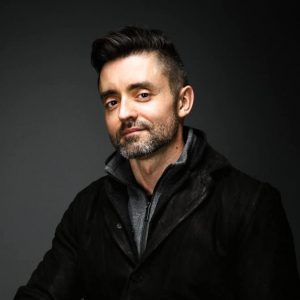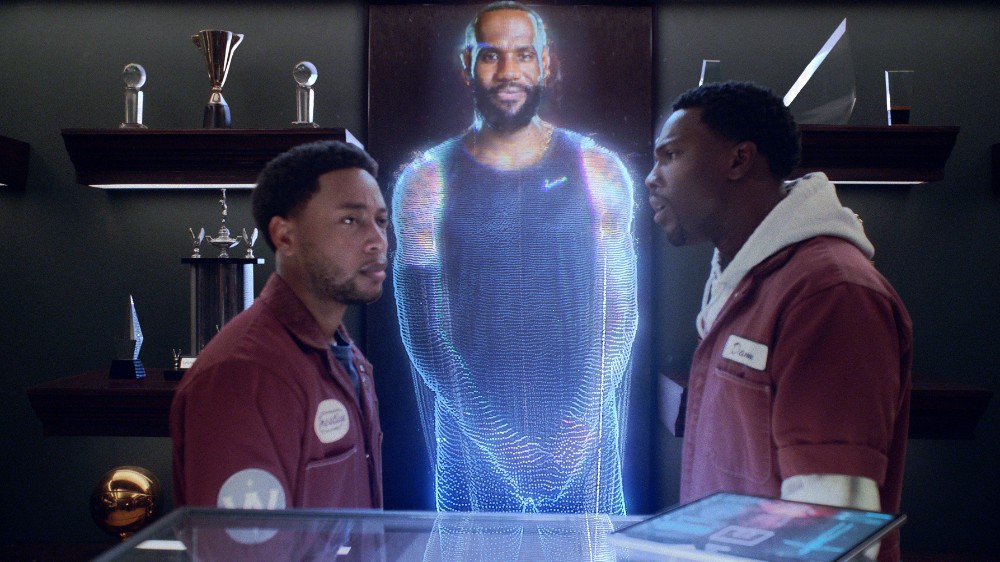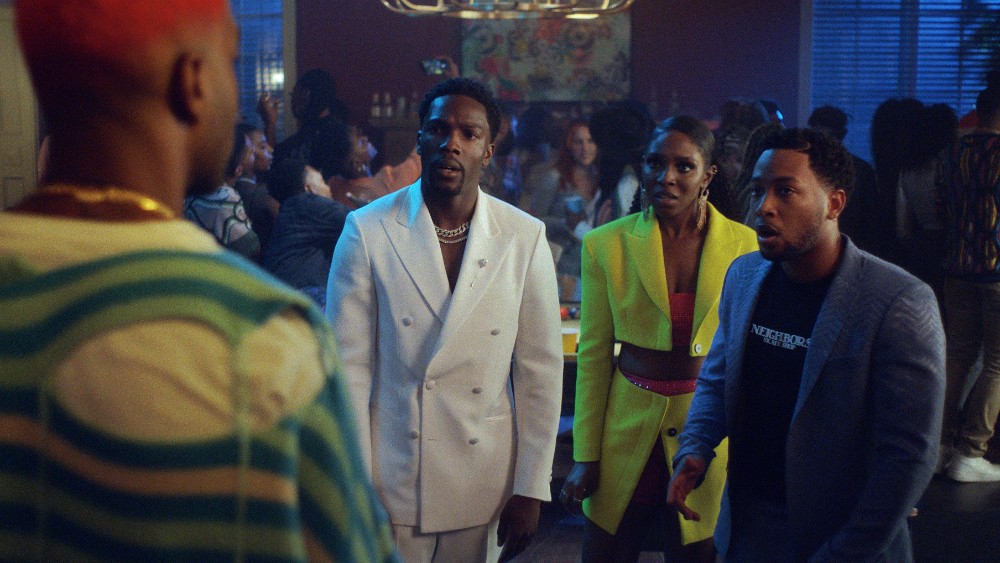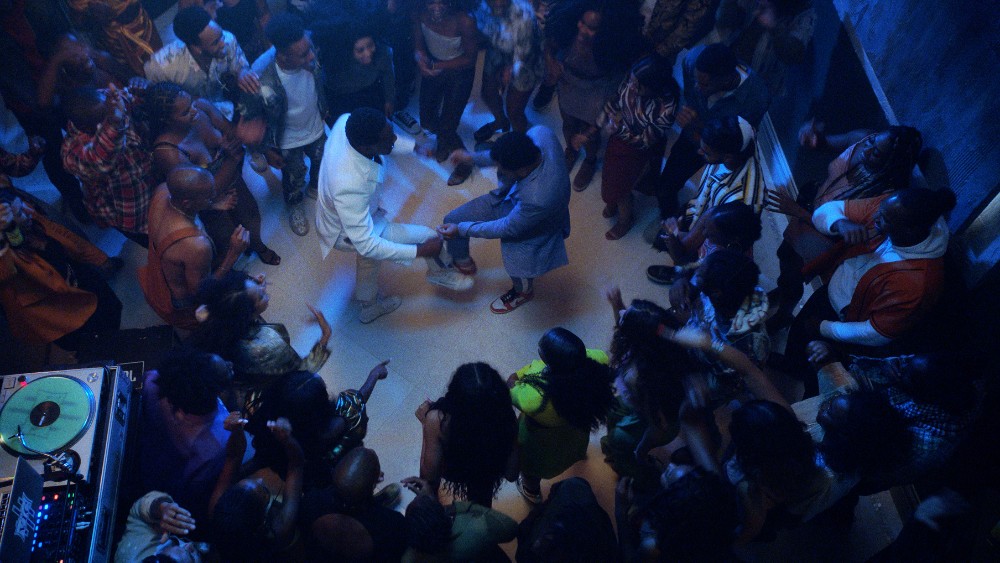A modern take on House Party from music video director Calmatic is currently playing in theaters thanks to Warner Bros. and New Line, and though it might only have a few things in common with the movie starring Kid ‘n Play, the first-time director wanted to maintain some of the look and feel of the original even though times have changed quite a lot in the 30-plus years since that hit 1990 comedy.
To do so, he brought on DP Andrew Huebscher, who some might assume is a young gun in the world of cinematography, but he actually has a 20-plus-year career that has run a range of genres, though it has mostly found him working in the indie realm on films like 2019’s Big Time Adolescence starring Pete Davidson.
The new version of House Play stars Tosin Cole (Doctor Who) and Jacob Latimore (Detroit) as best friends Damon and Kevin, wannabe L.A. promoters who get the crazy idea of throwing a party at LeBron James‘ mansion, where they’re working as housecleaners. It seems like a good way for them to make money and a name for themselves, until various friends and others show up, and the party gets out of control.
Below the Line spoke with Huebscher over the phone last week to learn what went into bringing House Party to modern audiences while still maintaining that ’90s look and feel.

Below the Line: I’m not sure I realized how long you’ve been working in camera and shooting films, so what got you started down that road?
Andrew Huebscher: Like many cinematographers and filmmakers, I had a passion for filmmaking growing up. So I did Super 8 movies as a kid, and then later, public access TV, because I grew up in Minnesota, and that’s what was available to me. I got into USC film school, so I moved out to California and met a lot of people, and just started shooting other short films. I knew I wanted to shoot from a pretty young age, so I got into shooting short films.
While I was in school, I started shooting really low-budget music videos on the weekends. We would shoot on Super 16mm, we’d transfer at Company 3 at like two o’clock in the morning, when we could get a discounted rate, and just really cut our teeth on those kinds of projects. After graduating, I won the ASC Heritage Award, and I just kept on shooting. I continued to do music videos, I shot a lot of short films, even after college, for friends of mine, and then gradually got into doing feature work. Over the years, I’ve worked in almost every genre. I’ve had a chance to shoot a Western, I’ve done horror, a fair amount of documentary work, and of course, comedy.
BTL: It’s interesting to hear you wanted to shoot from a very young age, which is not something I would expect many young people to even know what a cinematographer does. Maybe kids are smarter these days.
Huebscher: I remembered at the age of 13, I’ll never forget… I walked into a comic book store. I was never really into comic books that much, but I had a friend who was, and I veered toward the movie journals because I was into films. I saw American Cinematographer, and I’d never heard of it. This would have been 1992, and I picked up an issue. I think it was [Memoirs of an] Invisible Man, I’d have to check, but it was a Chevy Chase movie that had a lot of visual effects. Of course, the vast majority of the language kind of went over my head, but I became a subscriber shortly thereafter, and I haven’t stopped since. In fact, in my living room, I’ve got volumes of decades of the magazine in print, which I won’t part with.
BTL: You didn’t work your way up through other camera positions like some cinematographers do, as you were shooting from the get-go, though I think I saw that you’ve done some camera operating as well, no?
Huebscher: I’ve done a mix over the years. Friends of mine that are also DPs, I’ve worked for them, usually as an operator, and vice versa. It was the group of filmmakers that I was coming up with at a school. It was the beginning of that new trend towards shooting when you get out of school. I did have some opportunities, and I worked as an AC for a little while just to understand that job. I had an internship on Chicago Hope, which was a CBS show in the late ’90s, it was their version of ER, and the DP was Jim Bagdonis, and I learned a lot from him and his team. Mainly, I decided to grab the bull by the horns and go after my passion.

BTL: I’m not sure, but House Party may be your widest theatrical release. Had you worked with Calmatic before on something else? How did you meet him?
Huebscher: We got connected through my agent, but this was our first time working together. I was familiar with his work, like the [Lil Nas X] “Old Town Road” music video, and Pharrell‘s “Entrepreneur” video. When I got the call and looked him up and looked more into his work, I knew I just had to meet this guy, because there was such a unique quality to his body of work, that I was just in awe of.
BTL: What were some of your conversations like? Did he have some ideas of how he wanted House Party to look?
Huebscher: I knew this wasn’t going to be like anything else that’s out there now. Ultimately, the film was about a relationship between two friends who are struggling to make a name for themselves. In the spirit of the franchise, it veers into some dark corners along the way. I knew that Calmatic had the chops to take it there, but one of the first things he conveyed to me was he didn’t want the movie to look super modern with slick lighting and zippy camera moves, and I embraced this idea immediately. We didn’t set out to make Euphoria.
We researched a lot of early ’90s cinema, looking at John Singleton [and] Spike Lee. I think Baby Boy was a big reference for us, ATL. We both have a fondness [for] the ’90s aesthetic, and I think there’s a quality to it that’s really hard to emulate. I mean, you see it in the quality of the light. A lot of it had to do with film stocks at the time. Of course, movies were printed [and] went through a completely analog process then, but there was harder light, deeper blacks, sharp lenses that aren’t sterile, [and] more depth of field.
We took all of this in, and then looked at the design elements that were coming into play, what our locations looked like, which by the way, there were no builds. Everything was entirely on location, and we created our look and approach from there. The idea was, I wanted to have a progression in the film. It opens in South L.A., kind of establishing the neighborhood. It’s more natural, it’s muted, it’s softer, and then when we start to introduce the characters and arrive at the mansion, we really wanted to convey a sense of scale and luxury. That dictated a lot of the light and framing. We want the mansion to almost dwarf these guys, and it should feel luxurious and grand. As we progress into the party scenes, we introduce more color and expressive elements, the lighting gets darker. The Illuminati sequence had a lot of business in there for us.
We would have loved to have shot on 35mm but were only budgeted for digital. I chose OG ALEXA Minis recording to ARRIRAW. To combat the sharpness and crispness of digital, I underexposed most scenes, sometimes by as much as a couple of stops. This yielded a more distressed texture, with some grit and imperfection. I used a similar technique on Big Time Adolescence. Fotokem in L.A. helped us develop a show LUT based on these tests.
BTL: Do you have a preference as far as lenses you like to use or things you wanted to use for this film in particular?
Huebscher: We must have looked at dozens of lenses from the arsenal of Panavision Hollywood, aided by gurus Ye Woo Kim and Guy McVicker. Ultimately, I chose Kowa spherical primes. They had a unique quality I wasn’t seeing in other glass, which I’d characterize as having a gentle rendering of details, natural color separation, and gorgeous warm flares that can wrap around a subject without falling apart. To round out the set, Panavision “de-tuned” some of their more traditional zooms to match the look of the Kowas. For the film’s flashbacks, we chose Panavision Ultra Speed MKII lenses, combined with net material behind the lens to lend these moments a “fuzzy memory” sort of vibe.

BTL: Jumping ahead a bit, were you actually shooting at night, or were you shooting day-for-night, since once it gets to the party, it’s all at night?
Huebscher: We scouted a lot of mansions, and of course, we would have loved to build our dream mansion, or at least the interior on a stage. But ultimately, where we landed was this beautiful new construction way out in Monrovia, and there were a lot of huge windows, but the studio required us to do an engineering report at the location. They sent out a team of people, and it was determined that the stone and a lot of the surfaces and property were too fragile, and they wouldn’t be able to support any kind of large lifts. We weren’t allowed to have condors, we weren’t allowed to have scissor lifts. It was really upsetting news for us, for myself and the gaffer and key grip, because it just meant that it was going to severely limit our ability to do some of the things we wanted to do. We had to get very creative.
Unfortunately, this also meant we were unable to do any sort of day-for-night, because the amount of tenting and gear required, and the time it would take, it just didn’t comport with the schedule. We shot all the party stuff night for night. I think there might have been one or two moments where we had to throw solids up as the sun was coming up. It was also around August of 2021 that we were shooting that, so we were somewhat limited on how much night we had.
You combine that with shooting in a pandemic and COVID, and we had to take air breaks. In the words of my Key Grip, Tom Whitehead, this is a logistically challenging movie, more than anything else. We had a COVID situation emerge that shut us down for a week, so that rippled our schedule, because actors had other commitments, and they had to recalibrate the schedule to accommodate that shift. That meant we would have to leave a location, come back to a location, leave, and then in one case, I think we came back a third time, just in order to shoot actors out to fulfill their other commitments.
BTL: In a similar vein as my day-for-night question, I’m curious about shooting daytime outdoors in LA. I assume having enough light is never a problem, but is there a possibility of having too much light? How do you deal with shooting outdoors when there is so much natural light?
Huebscher: You mean in terms of day exteriors? I mean, you’re right. We were shooting in the middle of summer in L.A., and you can still get overcast days, but for me, it was just about trying to control the light as much as possible. Sometimes, we didn’t have the schedule or the ability to bring in big lighting units, particularly shooting at the mansion. What I would say about the daytime work, is that I like to control it as much as possible, so there’s a scene in front of Kevin’s house, he gets confronted by these promoters that we end up meeting and they’re kind of thugs.
There’s a fight that ensues later with a koala. For that whole scene, we flew a 20x flyswatter with half silent sail and a double net, to knock down the light and make it a little moodier. We didn’t want to just play this as natural light. We wanted this moment to look a little more sinister and dramatic. Then there were other scenes, where we were unable to do that.
There’s a conversation between Kevin and Damon on the basketball court at the mansion. Due to all the engineering restrictions there, we really can only just wheel stuff in on the ground, which of course, if you’re trying to do big wide shots, becomes very restrictive. Then you try and pick the best times of day to shoot, but you don’t always get your way, so it becomes a little bit of a dance, particularly with the AD department, to try and find the best marriage of logistics and look.
BTL: For the Illuminati scene you mentioned, did they just redress the mansion for those scenes, or was that a different location altogether?
Huebscher: No, that was the Los Angeles Theater downtown LA. That was another location that we had to leave and come back [to] later, but there were two main parts to it. One is the sort of the Grand Lobby, and that’s where we created this party. Of course, we took cues from Eyes Wide Shut, and we wanted to feel like we were stepping into a different film altogether. At this point in the movie, it really is surreal, and the guys are a little inebriated, particularly when they come out of this. It’s just meant to really throw you.
Then there’s the gladiator sequence, which happens right after the party when they get discovered, and there’s sort of this mad mob that pulls them out. We don’t quite know where we are at this point. We wanted it to slowly unfold, and that’s actually this downstairs lobby, I think it might have been used as a bar or something, that that takes you to the restrooms at the L.A. Theatre. We looked at possible houses that could serve, that could give us all of these locations, and nothing else came close. When we saw the LA Theater, you would have thought that it was written for this place, because it just worked so perfectly for us.

BTL: I’m curious about how you shot the titular party because there are a lot of people packed into that space, so was it hard to maneuver cameras and other equipment around given the crowd? How did you get what you needed in terms of coverage during the party scenes?
Huebscher: One thing that we found was really hard to find the perfect mansion. A lot of modern mansions don’t have large living rooms, and this one had a somewhat narrow living room. We were concerned about having enough space to shoot, but to answer your question, it becomes a game of Tetris where it’s like you only bring into the space, the things you need. But there was a lot of, ‘We’ve got to move from this room to this room, which means 19 carts have to move out of the way, lights have to move,’ and it just becomes a lot more time-consuming. We became very efficient, and I had a fantastic First Assistant Director, Eric Lasko, who helped us orchestrate the movement and keep us shooting. But it wasn’t easy. I mean, modern cameras are heavy and bulky and require a lot of support, and you add in extras and dark scenes, and we certainly had our work cut out for us.
BTL: I’m not sure if you’ve seen Steve McQueen’s Small Axe movie, Lovers Rock, but that movie has this amazing party scene in a very small space that seemed like it would have been impossible to shoot.
Huebscher: My background is in independent films primarily, so I’ve had a lot of experience with how to maximize production value in impossibly tight spaces. We had a lot of time to research the location, and we shot mostly in chronological order, so we could build up to the bigger pieces later. It was something my team and I just kept revisiting daily — how to consolidate and make it efficient and [figure out] where we could hide things because it really was a unique challenge.
After our interview, Andrew reached out with a few other interesting notes about shooting the film, including a spoiler for those who haven’t seen the film yet.
On cross-shooting/multi-cam:
It was important that Calmatic had sufficient time to work on the performances. The shooting script contained considerably more dialogue than made the cut, and some scenes were omitted entirely. This, combined with a tight schedule, meant we often needed to cross-shoot coverage. This is not uncommon in the comedy world and is preferred by some directors I work with, in order to capture improv moments. (Examples of this in my own work: The Binge and It’s A Wonderful Binge; TOSH.0, for which I shot hundreds of multi-cam style sketches). Unfortunately, sacrifices have to be made to the lighting because you can’t place lights and create a grip forest for a close-up, as the other camera would see the gear. Chief Lighting Technician (CLT) Christian Grosselfinger and Key Grip Tom Whitehead were instrumental in helping me design very fast setups to accommodate this way of working, without major compromises to the look. I also want to credit veteran “A” Camera/Steadicam Operator Kirk Gardner for his tireless commitment to beautiful frames — and he worked on the original 1990 House Party!
On the film’s one-on-one basketball game with LeBron James (spoiler alert):
At the end of the film, Damon challenges LeBron to a one-on-one game in his backyard court. The scene takes place at night, and we knew we would have limited time with LeBron — I think it ended up being 5 or so hours. We shot with three cameras shooting 270º, including one on a 50′ Technocrane. It opens with a dramatic confrontational beat, for which we cross-shot both closeups and a master simultaneously, and follows with a fast-moving game between the gents. Given the engineering restrictions, lifts were out of the question. We would have rigged lighting to the house in the background, but some shots were low wides that looked all the way into the sky.
In the end, we erected a 12×20 “moonbox” outfitted with a dozen or so ARRI S60 Skypanels pushing through light grid diffusion, with an LCD to keep the light from spilling all over the extras on the sides of the court. We supplemented with ARRI 5K’s and large Chimeras to back-cross-key the opening, and PAR cans to accent architecture and trees. There’s a brief lightning effect during LeBron’s signature chalk toss, which we accomplished with Elation Artiste Monets, probably on super tall stands or scaffolding. The main overhead rig was supported by [a] square box truss on chain motors, which could lower to the court for speedy adjustments. The plan worked brilliantly and helped us to make our night before the sun crept up and LeBron turned into a pumpkin.
House Party is now playing in theaters courtesy of Warner Bros. Pictures and New Line Cinema.





